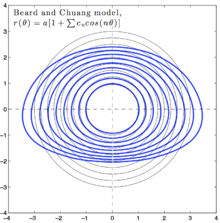Beard and Chuang model
The Beard and Chuang model is a well known and leading theoretical force balance model used to derive the rotational cross-sections of raindrops in their equilibrium state by employing Chebyshev polynomials in series.

The radius-vector of the raindrop's surface in vertical angular direction is equal to
,
where shape coefficients are defined for the raindrops with different equivolumetric diameter as in following table
| d(mm) | n = 0 | 1 | 2 | 3 | 4 | 5 | 6 | 7 | 8 | 9 | 10 |
|---|---|---|---|---|---|---|---|---|---|---|---|
| 2.0 | -131 | -120 | -376 | -96 | -4 | 15 | 5 | 0 | -2 | 0 | 1 |
| 2.5 | -201 | -172 | -567 | -137 | 3 | 29 | 8 | -2 | -4 | 0 | 1 |
| 3.0 | -282 | -230 | -779 | -175 | 21 | 46 | 11 | -6 | -7 | 0 | 3 |
| 3.5 | -369 | -285 | -998 | -207 | 48 | 68 | 13 | -13 | -10 | 0 | 5 |
| 4.0 | -458 | -335 | -1211 | -227 | 83 | 89 | 12 | -21 | -13 | 1 | 8 |
| 4.5 | -549 | -377 | -1421 | -240 | 126 | 110 | 9 | -31 | -16 | 4 | 11 |
| 5.0 | -644 | -416 | -1629 | -246 | 176 | 131 | 2 | -44 | -18 | 9 | 14 |
| 5.5 | -742 | -454 | -1837 | -244 | 234 | 150 | -7 | -58 | -19 | 15 | 19 |
| 6.0 | -840 | -480 | -2034 | -237 | 297 | 166 | -21 | -72 | -19 | 24 | 23 |
Applications
The description of raindrop shape has some rather practical uses. Understanding rain is particularly important with regard to the propagation of electromagnetic signals. A portion of atmosphere that has rain in it, or a rain cell, has the characteristic of attenuating and de-polarizing EM signals that pass through it. The attenuation of such a signal is approximately proportional to the square of the frequency of the signal, and the de-polarization is proportional to the shape distribution of raindrops in the rain cell.
References
- K. V. Beard and C. Chuang. A new model for the equilibrium shape of raindrops. Journal of the Atmospheric Sciences, 44:1509-1524, 1987.